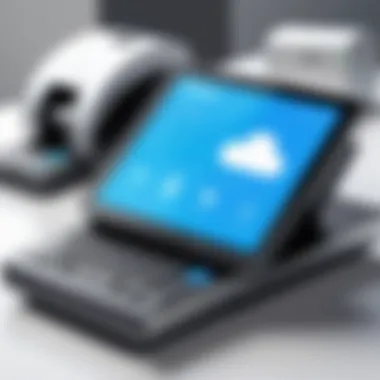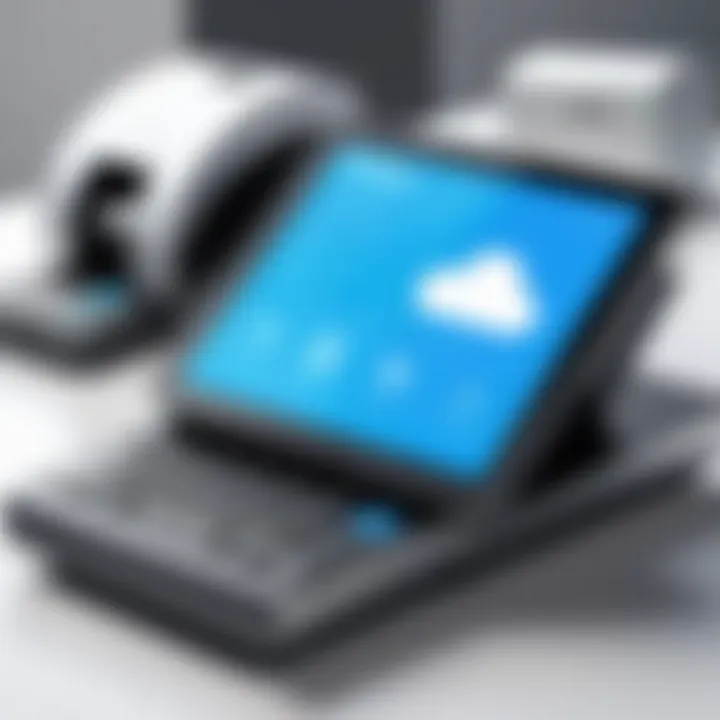Exploring the Functions of POS Systems in Modern Businesses


Intro
Point of Sale (POS) systems have transformed the landscape of modern business operations. These systems are not just simple cash registers but comprehensive solutions that manage transactions, inventory, and customer engagement in real-time. With the advancement in technology, the capabilities of POS systems have expanded significantly, making them essential tools for retailers, restaurants, and service providers alike.
As businesses strive for efficiency and enhanced customer experiences, understanding the functionality of POS systems becomes increasingly relevant. This article will delve into the various functions of POS systems, exploring how they streamline operations and improve business analytics.
Moreover, we will examine the critical elements that make up these systems, their performance in real-world scenarios, and the unique advantages they offer. The discussion will also highlight the latest trends in mobile and cloud-based POS solutions and their implications for diverse industries.
Features Overview
POS systems come with a variety of features designed to meet the demands of modern businesses. Their effectiveness hinges on both hardware and software components that work seamlessly together.
- Key Specifications
POS systems generally include hardware like touchscreen terminals, barcode scanners, card readers, and receipt printers. The software, on the other hand, encompasses user interfaces, inventory databases, and reporting tools.
• Touchscreen Interface: User-friendly design enhancing ease of use.
• Barcode Scanning: Automated product identification streamlining checkout processes.
• Card Processing: Secure payment acceptance, crucial for customer transactions. - Unique Selling Points
Businesses benefit from unique aspects of POS systems that set them apart from competitors.
• Real-time Inventory Management: Immediate updates on stock levels help prevent stockouts.
• Sales Analytics: In-depth reports aid in understanding customer behavior and sales trends.
• Customer Engagement Tools: Features that allow businesses to create personalized experiences.
Performance Analysis
Understanding how POS systems perform in real-world applications is essential for any business considering their adoption.
- Benchmarking Results
Various studies have indicated that businesses using POS systems see improvements in efficiency and sales. For example, retailers report up to 20% increase in sales due to better inventory management and faster checkout processes. - Real-world Scenarios
Consider a restaurant utilizing a POS system. The staff can take orders directly on tablets, reducing wait times. Additionally, the system can track which dishes are popular, helping owners make informed inventory decisions.
"Investing in a robust POS system can yield significant returns through improved efficiency and enhanced customer satisfaction."
Preface to POS Systems
The significance of Point of Sale (POS) systems in contemporary businesses cannot be overstated. As operational hubs, these systems streamline transaction management, contributing to a smoother customer experience and efficient business operations. In this section, we dissect what POS systems are, their essential features, and their historical evolution, paving the way for a fuller understanding of their core functions.
Definition and Overview
A Point of Sale system refers to the hardware and software that businesses utilize to facilitate sales transactions. Typically, it encompasses a cash register, a computer, a touchscreen monitor, barcode scanners, and credit card readers. The primary objective is to manage transactions making it easier for businesses to keep track of sales, inventory, and customer information.
POS systems have evolved with technology, providing features that go beyond mere sales transactions. They can manage inventory, generate sales reports, and analyze customer preferences. Their ability to collect and analyze data is crucial for businesses looking to enhance operational efficiency and customer engagement.
An efficient POS system allows for real-time tracking of inventory levels, ensuring that stock is replenished timely. It plays a vital role in reducing human error during transactions and streamlining payment processes, thus elevating the overall customer service experience.
Historical Development
The evolution of POS systems dates back to the late 19th century. Initially, businesses relied on manual cash registers. The first mechanical cash register, the National Cash Register, was invented by Charles F. Kettering in 1883. This innovation marked the start of a new way to manage transactions more securely and efficiently.
As technology progressed, the adoption of electronic cash registers became widespread in the 1970s and 1980s. These systems provided more functionalities, including electronic record-keeping and basic inventory management. Companies such as IBM and NCR began developing more sophisticated systems that integrated computer technology into sales processes.
In the late 1990s and early 2000s, the introduction of the internet led to the rise of cloud-based POS systems. They provided businesses with flexibility and remote access to their sales data. Today, with advancements in technology, mobile POS solutions have emerged, allowing sales to be processed virtually anywhere. This development illustrates how far POS systems have come in enhancing business operations.
"POS systems have transitioned from simple cash registers to complex tools for data management and customer engagement."
Core Functions of POS Systems
Point of Sale systems play a crucial role in modern businesses. Understanding the core functions of these systems is essential for optimizing operations. POS systems do more than handle transactions. They integrate various business processes into a cohesive solution, ultimately supporting decision-making and improving customer relations.
Transaction Processing
Transaction processing is perhaps the most fundamental function of any POS system. It allows businesses to process sales quickly and efficiently. A effective POS system captures the details of each sale, including items purchased, payment method, and customer information. This information is stored for future reference.
The speed of transactions can significantly enhance customer satisfaction. Long wait times can lead to poor experiences, especially in busy environments such as retail stores or restaurants. Incorporating features like barcode scanning and contactless payment solutions can optimize transaction speed further.
Furthermore, accuracy is vital in this process. An efficient POS system minimizes human errors during the checkout process. This accuracy translates into better inventory management and financial reporting.
Inventory Management
Effective inventory management is another core function of POS systems. Managing stock levels efficiently can have profound impacts on a business's bottom line. A POS system helps track inventory in real time. This allows businesses to understand which products are selling well and which are not.
Monitoring stock can prevent overstocking and stockouts. If a popular product is constantly out of stock, businesses may lose customers. Conversely, having excess inventory ties up capital that could be used elsewhere. Integration with suppliers through the POS can enhance purchasing decisions.
Moreover, detailed inventory reports generated by the POS system aid in making data-driven choices. Businesses can analyze trends and adjust their purchases accordingly, ensuring they meet customer demand effectively.


Sales Reporting
Sales reporting is critical for evaluating business performance. POS systems generate sales reports that help businesses identify trends over time. These reports can be broken down by day, product, or employee, providing deeper insights into sales performance.
Understanding sales data is essential for strategic planning. For example, if a particular item consistently underperforms, businesses may choose to run promotions or consider discontinuation. Reports can also highlight peak sales times, allowing for better staffing decisions.
The data collected is invaluable for forecasting. For instance, if sales typically increase during the holiday season, businesses can prepare by adjusting inventory levels accordingly. Accurate forecasts can significantly contribute to business growth.
Customer Management
Customer management through POS systems is vital in fostering loyalty. POS systems can collect valuable customer data, such as purchase histories and preferences. This information allows businesses to understand their customers better and tailor marketing efforts.
Implementing loyalty programs through the POS can encourage repeat business. Personalized promotions based on previous purchases can enhance customer satisfaction, creating a more engaging experience. Access to this data also facilitates targeted marketing strategies.
In addition, customer feedback can be integrated into the system. This can help businesses improve their offerings and overall service quality, ensuring that they stay relevant in a competitive market.
"A well-integrated POS system not only enhances transaction speed but also elevates customer loyalty and inventory efficiency."
Ultimately, the core functions of POS systems are interconnected. Transaction processing, inventory management, sales reporting, and customer management together create a robust framework. This framework supports the seamless operation of modern businesses in various sectors.
Hardware Components of a POS System
In examining the functions of POS systems in modern businesses, it is crucial to understand their hardware components. These elements form the backbone of any POS solution, providing the necessary tools for transaction processing, inventory management, and customer interactions. The right hardware can significantly enhance efficiency and accuracy, directly impacting the overall operational success of a business.
Physical Terminals
Physical terminals are the central hub of any POS system. They serve as the point where sales occur, enabling cashiers or staff to process payments quickly. Several key elements define physical terminals:
- Touchscreen Interfaces: Many modern terminals feature touchscreen displays. This technology simplifies interactions, allowing for faster training and a more intuitive user experience.
- Barcode Scanners: Integrated barcode scanners make it easy to ring up items quickly. Staff can scan products, reducing the likelihood of human error in pricing and inventory tracking.
- Payment Processors: The ability to accept various payment methods—credit cards, debit cards, mobile payments—is vital. Physical terminals should support multiple transaction types to meet customer preferences.
The combination of these elements enhances a business's ability to serve customers efficiently and maintain accurate records. As customer demands evolve, investing in high-quality physical terminals can lead to better customer satisfaction and increased sales.
Peripheral Devices
Peripheral devices extend the capability of physical terminals. They add functionality that benefits both staff and customers. Here are some common peripheral devices used in POS systems:
- Receipt Printers: Generate paper receipts for customers, providing necessary proof of purchase and improving the customer experience.
- Cash Drawers: Securely store cash and provide easy access for staff during transactions. The integration of cash drawers with terminals can automate the opening process, enhancing security.
- Customer Displays: Show transaction details to customers in real-time, improving transparency and confidence in the transaction process.
These peripheral devices are not just add-ons; they are essential for ensuring that the POS system functions smoothly. When selecting peripheral devices, consider compatibility with the existing hardware and software to maximize operational efficiency.
"The hardware components of a POS system are foundational for creating seamless transaction experiences in any retail or service environment."
Software Aspects of POS Systems
In the realm of modern business, the functionality and capabilities offered by POS systems are largely driven by their software components. The choice of software not only impacts the overall performance but also defines how effectively businesses can manage transactions, inventory, and customer relationships. Understanding the software aspects is essential for evaluation and strategic implementation.
Operating Systems
The operating system forms the backbone of a POS system. It dictates how the hardware interacts with software applications and manages resources. Various operating systems are used in POS systems, including Windows, Linux, and proprietary systems. Each has its strengths and weaknesses.
- Windows-based systems are known for their user-friendly interface and extensive support for third-party applications. Their popularity among retail establishments is notable.
- Linux-based systems are often favored for their stability and security. They can be customized significantly, making them suitable for businesses with specific requirements.
- Proprietary systems, like those from Square, offer simplicity and integrated features tailored for specific business needs.
Functional advantages can be obtained by selecting an operating system that aligns with business goals. Also, updating the operating system regularly ensures security and compatibility with new features.
Cloud-Based Solutions
Cloud-based POS systems have transformed the traditional landscape by allowing businesses to operate without the constraints of location and on-premise infrastructure. This approach provides various advantages:
- Accessibility: Users can access their data and function from any device with internet connection.
- Cost-Effectiveness: Many cloud-based systems follow a subscription model, which can reduce upfront investment costs. Maintenance and updates are handled by the provider, alleviating the burden from internal IT resources.
- Scalability: As businesses grow, it's easy to add new functionalities or services without major hardware changes.
Security concerns remain a priority with cloud systems. Encryption and compliance with regulations like GDPR are essential. It's paramount that businesses thoroughly vet their cloud service providers to ensure data security and reliability.
"The shift towards cloud-based POS systems highlights the necessity for businesses to adapt to technological advancements for competitive advantage."
Benefits of Implementing POS Systems


Implementing a Point of Sale (POS) system can transform a business's operational landscape. The advantages are notable and often immediate, marking a significant improvement in efficiency and customer satisfaction. This section will discuss three main benefits: enhanced efficiency, improved customer experience, and data-driven insights.
Enhanced Efficiency
Efficiency is one of the primary reasons businesses adopt POS systems. By automating transaction processes, these systems can reduce the time employees spend on manual entry and other repetitive tasks.
A modern POS system can streamline operations in many ways:
- Faster Checkouts: Transactions are processed quickly, reducing wait times for customers.
- Automated Inventory Updates: As sales occur, inventory levels are updated automatically, which helps in maintaining accurate stock levels.
- Simplified Reporting: With a centralized system, generating sales reports takes moments, enabling business owners to make informed decisions promptly.
The integration of hardware and software components facilitates a seamless flow of information. This can translate into lower labor costs, as staff can focus on customer engagement rather than administrative duties.
Improved Customer Experience
Enhancing customer experience is fundamental for any business aiming to thrive in a competitive market. A robust POS system offers various features that can significantly elevate this experience:
- Loyalty Programs: Many systems support integrated loyalty programs, encouraging repeat business through rewards.
- Personalized Service: By storing customer preferences and purchase history, staff can offer tailored recommendations.
- Multiple Payment Options: Accepting various payment methods, from credit cards to mobile payments, makes transactions convenient for customers.
"Customer satisfaction directly correlates to how efficiently a business operates."
Improved customer experience is a direct outcome of the efficiency gained by using a POS system. A happy customer is likely to return, driving up sales and building brand loyalty.
Data-Driven Insights
Data analytics is a powerful feature provided by advanced POS systems. Understanding customer behavior and sales trends can inform strategic decisions. The insights derived from POS data can include:
- Sales Trends: Identify peak selling times, allowing for better staffing or inventory decisions.
- Customer Preferences: Analyzing purchase patterns helps in personalizing marketing efforts and product offerings.
- Performance Metrics: Evaluate the effectiveness of promotions or product placements through performance tracking data.
By leveraging these insights, businesses can react quickly to changes in consumer behavior, effectively optimizing operations and maximizing profits. Data-driven decision-making is now essential in staying competitive.
The benefits of implementing POS systems are both broad and deep. By enhancing efficiency, significantly improving the customer experience, and providing valuable data insights, POS systems become indispensable tools in the modern business arsenal. Their relevance will continue to grow as technology evolves.
Challenges in POS System Implementation
Implementing a Point of Sale (POS) system is not a simple task. Businesses often face various challenges that can hinder a smooth transition. Understanding these challenges is crucial for successful implementation. Failing to address them can result in financial loss, operational inefficiencies, and poor customer experiences.
Cost Considerations
The initial cost of a POS system can vary significantly. Businesses need to evaluate their budget to understand what they can realistically invest. Costs often include hardware, software, installation, and ongoing maintenance. Additionally, training staff can add to the total expense.
- Hardware Costs: Devices like terminals, scanners, and printers are often required.
- Software Licensing: Some POS systems require yearly or monthly subscription fees.
- Training Expenses: Proper training ensures staff can use the system efficiently.
Despite these costs, a well-chosen POS system can lead to savings over time by improving efficiency.
A thoughtful analysis of costs can lead to better decision-making, ensuring that businesses choose the right POS system for their needs.
Integration with Existing Systems
Many businesses operate multiple software systems alongside their current POS system. This can include inventory management, accounting, and customer relationship management. Integrating the new POS into these existing systems is essential for streamlined operations. However, this process can be complex.
- Compatibility: Not all POS systems support integration with every software.
- Data Migration: Safely transferring data from the old systems to the new POS can be a challenge.
- Downtime: Transitioning could necessitate system downtime, which impacts operations.
Finding a POS system that fits well within the existing tech ecosystem minimizes these challenges. Companies should prioritize systems known for high compatibility and ease of integration.
In summary, while the challenges in implementing a POS system can be significant, addressing cost considerations and ensuring proper integration can lead to overall improved operations.
Future Trends in POS Technology
As technology continually evolves, the landscape of Point of Sale (POS) systems is also changing. Understanding these future trends is crucial for businesses seeking to stay competitive. These advancements not only enhance the functionality of POS systems but also significantly improve the efficiency and customer experience.
Mobile POS Systems
Mobile POS systems are becoming increasingly prevalent in today’s marketplace. These systems utilize smartphones and tablets as transaction processing devices, allowing businesses to operate in a more versatile manner. The importance of these systems cannot be understated. Businesses can conduct transactions anywhere, increasing the convenience for customers and making it easier to serve them efficiently.
- Convenience: Customers appreciate the ability to check out without waiting in long lines. This can enhance customer satisfaction and build loyalty.
- Versatility: Retailers can set up POS terminals at various locations, such as pop-up events or outdoor festivals, expanding their reach.
- Cost-effectiveness: Mobile POS solutions often require a lower upfront investment compared to traditional systems. This can be especially beneficial for small businesses or startups.


AI and Machine Learning Enhancements
The integration of artificial intelligence and machine learning in POS systems presents a transformative opportunity for businesses. These technological enhancements help in analyzing data more effectively, leading to informed decision-making.
- Personalization: AI can analyze purchasing behaviors and preferences, enabling businesses to provide tailored recommendations to customers. This can significantly improve the shopping experience.
- Fraud Detection: Machine learning algorithms can detect unusual patterns in transactions, allowing businesses to mitigate risks associated with fraud.
- Inventory Optimization: Businesses can leverage predictive analytics to manage inventory more effectively. This can minimize overstocking and stockouts, leading to better operational efficiency.
Ending of Future Trends
The exploration of future trends such as mobile POS systems and AI enhancements illustrates the evolving nature of POS technology. Businesses that adapt to these advancements will not only improve their internal operations but also enhance the overall customer experience. As technology progresses, embracing these changes is essential for sustaining competitive advantage.
Comparative Analysis of POS Systems
A comparative analysis of POS systems is essential for businesses seeking to implement the most effective solutions. With numerous options available, understanding the core differences can help businesses make informed decisions. This section will examine the key elements relevant to this topic, focusing on specific benefits and considerations that arise in a comparative context.
Leading POS Software Solutions
When assessing POS software solutions, several factors need attention. Each software might feature various components that cater to the unique needs of different businesses. Among leading POS software solutions, familiar names include Square, Shopify POS, and Lightspeed POS. Each of these systems offers specific capabilities:
- Square: Known for its ease of use and cloud-based management, Square is suitable for small to medium enterprises. It integrates payment processing with inventory management seamlessly.
- Shopify POS: Ideal for e-commerce businesses that also have a physical presence. It offers excellent integration with online stores, enhancing the omnichannel experience.
- Lightspeed POS: This is favored by retail and hospitality sectors for its advanced functionality, including detailed reporting and employee management features.
This comparative approach reveals key differentiators, such as ease of integration, user interface design, and support services. Making the right choice among these solutions often depends on specific business needs, scalability, and overall budget.
Industry-Specific POS Systems
Industry-specific POS systems are tailored to meet the distinct needs of different sectors. A typical POS system might not be adequate in specialized fields. Here are examples of systems designed for particular industries:
- Restaurant Management: Software like Toast POS is built for restaurants, focusing on order management, table reservations, and loyalty programs.
- Retail: Vend POS is specifically crafted for retail operations with features like multi-store management, stock control, and extensive reporting capabilities.
- Salon and Spa: Systems like Vagaro cater to salons and spas, providing appointment scheduling, employee management, and client profiles.
Having a tailored POS system can significantly improve operational efficiency and customer service. Identifying the right industry-specific POS can directly impact a business’s success.
This comparative analysis ultimately serves as a strategic approach to optimizing business operations through tailored POS systems.
Case Studies: Successful POS System Implementations
Case studies provide real-world examples of how various businesses successfully implement POS systems. They illustrate the diverse applications of these systems across sectors. Understanding these implementations can offer valuable insights for other businesses considering a POS system deployment. Each case highlights the specific challenges faced, the strategies employed, and the results achieved. This can inform best practices and inspire innovation in similar contexts.
Retail Sector Examples
In the retail space, POS systems are crucial for managing sales, inventory, and customer relationships. For instance, Target has adopted a sophisticated POS system to streamline its operations. With features like mobile scanning and integrated loyalty programs, the system enhances the customer shopping experience. Target’s POS not only supports quick checkouts but also collects valuable customer data, which helps in creating personalized promotions.
Another notable example is Best Buy. They invested in a multi-channel POS solution that integrates online and physical store transactions. This approach allows customers to buy online and pick up in-store, enhancing convenience. The POS system tracks inventory in real-time, aiding in accurate stock management and reducing overstock scenarios.
Hospitality Sector Examples
In the hospitality industry, POS systems are indispensable for managing orders and processing payments efficiently. A well-known case is that of Starbucks. They implemented a mobile POS that allows customers to order and pay via an app. This system not only speeds up service during peak hours but also gathers feedback and customer preferences, improving overall service.
Additionally, McDonald's has modernized its POS systems across locations. Through digital kiosks and mobile ordering, they enhance customer interactions and streamline order processing. The integration of sales data with inventory systems allows McDonald's to adjust menu offerings and staffing levels based on demand, leading to optimized operations.
All these case studies show that effective implementation of POS systems can significantly enhance operational efficiency and customer satisfaction in both retail and hospitality sectors. They point to the importance of aligning technology with business needs to achieve strategic advantages.
Closure
In the rapidly evolving landscape of retail and service industries, the conclusion of this article underscores the significance of Point of Sale (POS) systems. These systems are not merely transaction processing tools; they are integral to the operational efficiency and strategic progression of modern businesses.
Recap of Key Points
To summarize, POS systems offer multifaceted functionalities that go beyond traditional register roles. Key features include:
- Transaction Processing: Automates and secures sales, ensuring smooth customer transactions.
- Inventory Management: Provides real-time visibility into stock levels, alerting businesses to restocking needs.
- Sales Reporting: Delivers essential data analytics to inform business strategies and identify consumer trends.
- Customer Management: Enhances loyalty programs and personalizes the customer experience, fostering relationships.
These elements collectively enable businesses to improve efficiency, reduce errors, and enhance customer satisfaction, which are crucial for maintaining a competitive edge in today’s market.
Final Thoughts on POS Systems
In closing, the implementation of a robust POS system is a decision that can have profound implications for business success. Companies must consider their specific operational needs, budget constraints, and potential for future scalability.
Investing in a suitable POS solution is not just about keeping pace with technology but harnessing it for strategic advantage. The advent of mobile and cloud-based POS systems further exemplifies the shifts in consumer behavior and technological capabilities that businesses must adapt to. Ultimately, businesses equipped with effective POS systems are better positioned to respond to market changes and consumer expectations,
"The efficiency of operations directly correlates with the systems businesses choose to employ, and POS systems are central to that framework."
This conclusion provides a clear lens through which businesses can view their operational strategies, emphasizing that making informed decisions regarding POS technologies is not optional but essential.



